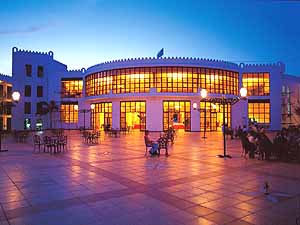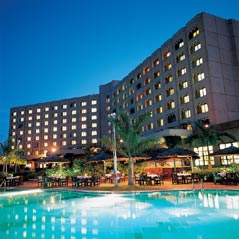Destination: |
Dar Es Salaam, Tanzania Hotels and City Guide
Dar Es Salaam Hotels and Dar Es Salaam Guide with Dar Es Salaam maps, top attractions, room reservations and hotel deals at a wide range of the best Dar Es Salaam hotelsDar Es Salaam - Outdoor Attractions
Outdoor Attractions - Tanzanias National Parks
Tanzania‘s magnificent scenic national parks in the Rift Valley provide the dramatic stage for the greatest natural show on earth, the annual migration of millions of animals during which a quarter of a million wildebeest will die. There are regular flights to Kilimanjaro Airport at Arusha from where safari companies will collect you.
Outdoor Attractions - The Serengeti National Park
Serengeti (14,763sq.km) means endless plains, home to 3 million large animals. It is adjacent to the Masai Mara in Kenya, Maswa Game Reserve to the west and Ngorongoro Conservation Area (8,300sq.km) to the southeast.
Governed by the rains, a cycle is followed in a clockwise direction from the southern plains, to the Western Corridor, to the Masai Mara in the north and then in a southeasterly direction towards the western border of the Ngorongoro Conservation Area back to short grass plains of Ndutu.
January and February is calving season for the ungulates. An unbelievable 8,000 calves are born each day. Calves attract predators, so if it’s the big cats you want to see, or just to watch the newborn wildebeest up and running alongside their mothers a few minutes after birth, this is the time to go. Amazingly, an estimated 400,000 calves are born within a 3-week period.
In April/May wildebeest and zebra herds begin their westerly and northerly migration to the woodland and grassier plains in the west of Serengeti. These animals are most compatible as they graze on different parts of the same grass. This is not the time to go as the heavy rains make roads impassable and visibility difficult.
In late May/early June when the rains have abated, the great trek begins as smaller wildebeest and zebra herds gather together and gradually move northwards in columns up to 40km long. This is also mating time of year.
In late June/July the drama begins in the Western Corridor of Serengeti stretching to Lake Victoria as the massed wildebeest and zebra herds meet their first large obstacle, the Grumeti River, home to extremely large crocodiles. Many don’t survive this crossing due to drowning and crocodiles that lie in wait for easy prey.
In late July/August when the grass turns yellow in the western Serengeti, the herds head further north to Kenya, but have to surmount another obstacle in their way, the Mara River with its waiting crocodiles.
Sufficient ungulates survive to fill the Masai Mara plains from September to November but where the herbivores go, the carnivores follow for abundant pickings.
The short rains start again in the south in November/December when the herds begin their return journey to the Serengeti plains in time to give birth from January to March.
There are many safari camps and lodges along the 1,000km migration route, all offering excellent sightings of the game at the appropriate times.
Outdoor Attractions - Ngorongora Crater
Covering an area of approximately 300 sq.km, this vast volcanic caldera, 600m deep and 22.5km across, is the world’s largest unbroken caldera. It is a magical natural wonder and breathtakingly beautiful shelter for approximately 30,000 large animals which spend their entire lives here. The unique wildlife refuge is probably the greatest highlight of East Africa and should not be missed. The almost circular floor of the crater is covered in open grasslands. Elephants are rare as they favour the lush highlands rain forests, like Lerai Forest, while giraffe prefer acacia trees higher up. Endangered black rhinos are surviving in this habitat. There is a fear that the lions of the crater may become inbred.
Lake Magadii, 14km wide, in the Ngorongora Crater turns pink with thousands of flamingos as they feed on the salt shores. Prolific birdlife is attracted to the lake, a treat for birdwatchers.
Nearby Olmoti and Empakaai craters form part of the eastern Rift Valley.
The steep-sided Olduvai Gorge in the eastern plains near Ngorongoro Crater is said to be the cradle of humanity, an important prehistoric site where palaeontological research has been conducted for more than 80 years. In 1959 Mary Leakey excavated fossilised evidence of human evolution, including early hominid footprints dating back 3.6 million years.
Many 5-star lodges dot the rim of Ngorongora offering spectacular panoramic views of the crater.
There are two daily flights from Arusha Airport to Manyara Airstrip, a 25-minute trip. The lodges will meet visitors and take them on guided tours down the steep slopes into the crater floor.
Outdoor Attractions - Kilimanjaro National Park
One of Africa’s icons, majestic Mount Kilimanjaro, is made up of three extinct volcanoes, Kibo, Mawenzi and Shiro. It rises through several ecosystems from tropical to arctic, starting from temperate plains at its base, then continuing through wet tropical rainforests beyond which heather and shrubs take over followed by open moorland above the cloudline, alpine desert where only mosses, lichens and everlasting flowers survive, and finally the snow- and ice-capped summit, Uhuru Peak, 3ºS of the equator. As it is a dormant volcano, niggling rumblings may be heard and gases seen as they escape from vents. The volcano’s 120m-deep central core belches sulphurous fumes in spite of freezing conditions.
There are five main hiking trails up the mountain: Marangu, Mweka, Umbwe, Shira and Machame, the first being the most popular. It will take five days to reach the summit and the distance to be walked is approximately 85km. Oxygen thins the higher one climbs when altitude sickness can become a problem. You are only permitted to climb the mountain with registered guides. Porters are recommended particularly when the air gets thinner.
Do not climb the mountain during the rainy seasons of April and May and the short rains in November as the routes can become impassable. The best trekking seasons are from January-March and June-October.
The Kilimanjaro National Park insists on pre-bookings to climb the mountain. Package tours are the best way to go. Most tour operators request that clients have medical check-ups before attempting the arduous trek.
Hotels in Dar Es Salaam, Tanzania
 | Holiday Inn Dar Es SalaamGarden Avenue Dar Es Salaam TANZANIA 152 guest rooms and 2 suites 5 floors We have a well lit and secure parking area which can accommodate at least 50 cars |  |
 | Golden Tulip Dar Es SalaamPO Box 20200, 6300, Dar Es Salaam This luxurious hotel is spacious with 84 comfortable designed rooms and 6 suites all with balconies offering splendid views over the Indian Ocean and the City. The hotel's architecture has traditional Arabic influences, which is characteristic on the East African Coast.... |  |
 | M�evenpick Royal Palm HotelP.O. Box 791,Ohio Street,Dar es Salaam,Tanzania, Hotel Introduction A beacon of hospitality in the heart of this Tanzanian city, the Moevenpick Royal Palm offers travellers a welcoming haven of comfort and unrivalled luxury. Stylish and elegant, the hotels magnificient lobby mirrors the sophisticated... |  |
Get Listed | Advertise | Contact | Terms | Privacy Policy | Legal | Mismi Digital | Partners | Sitemap




 TripAdvisor
TripAdvisor TripAdvisor
TripAdvisor